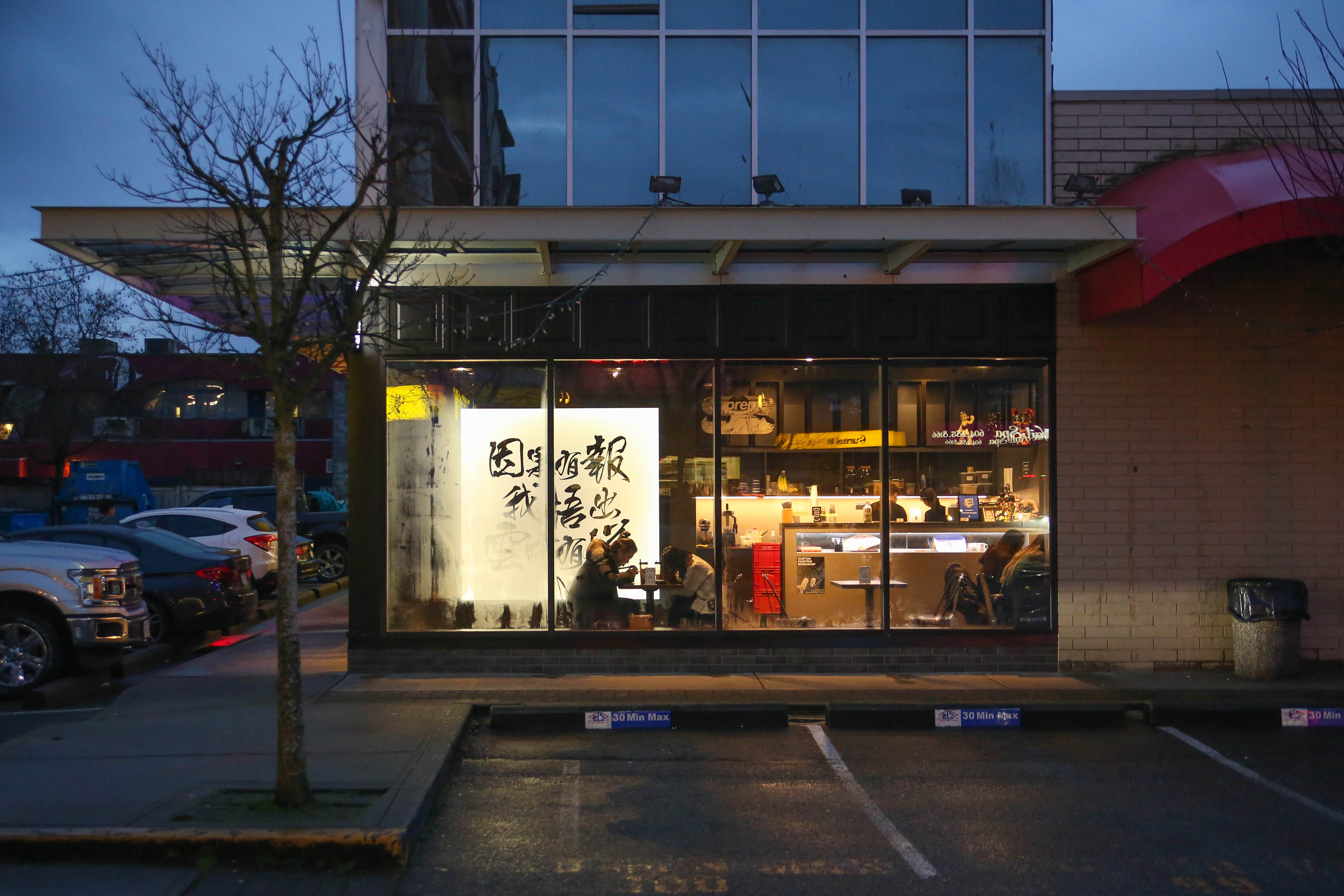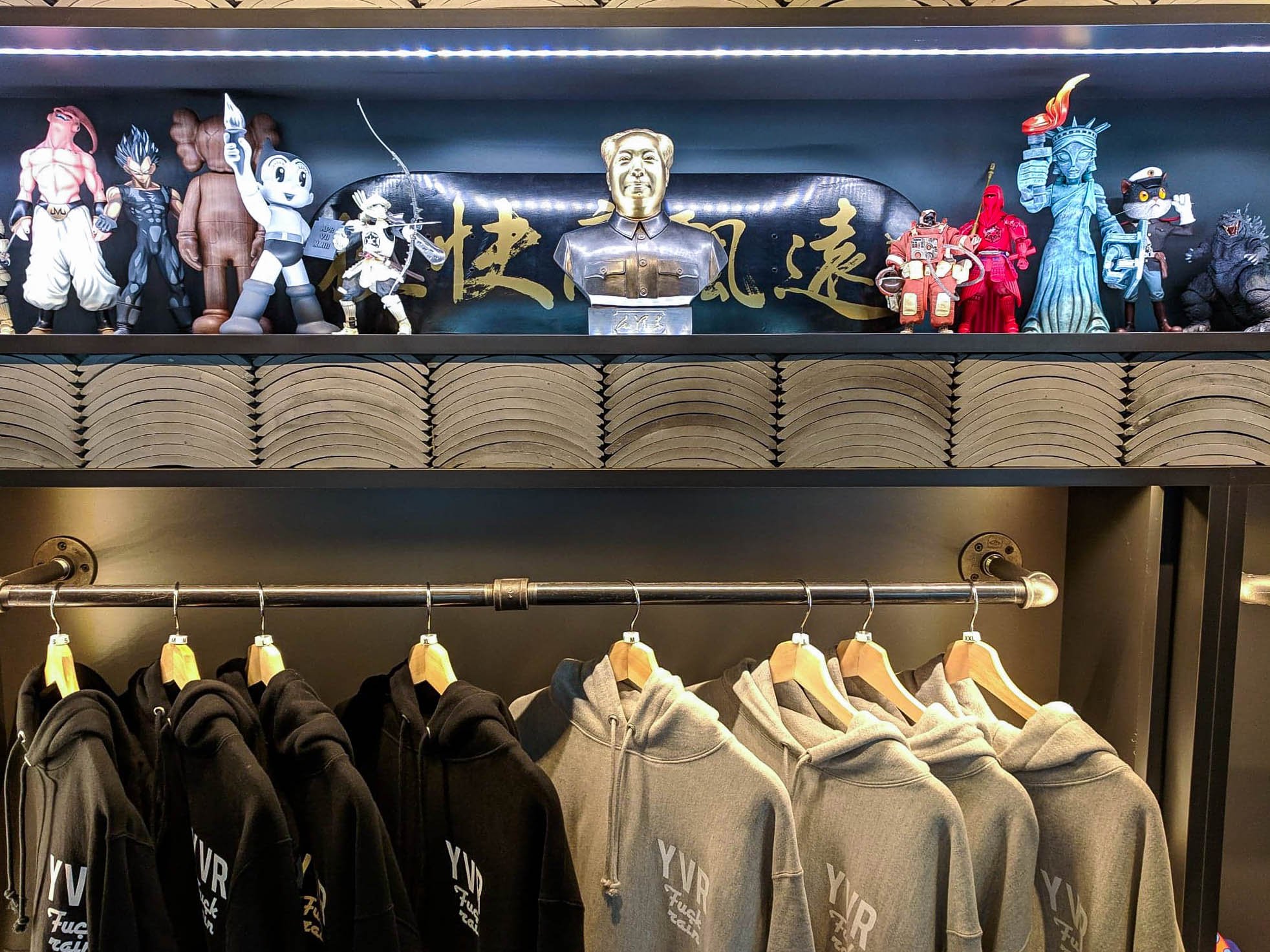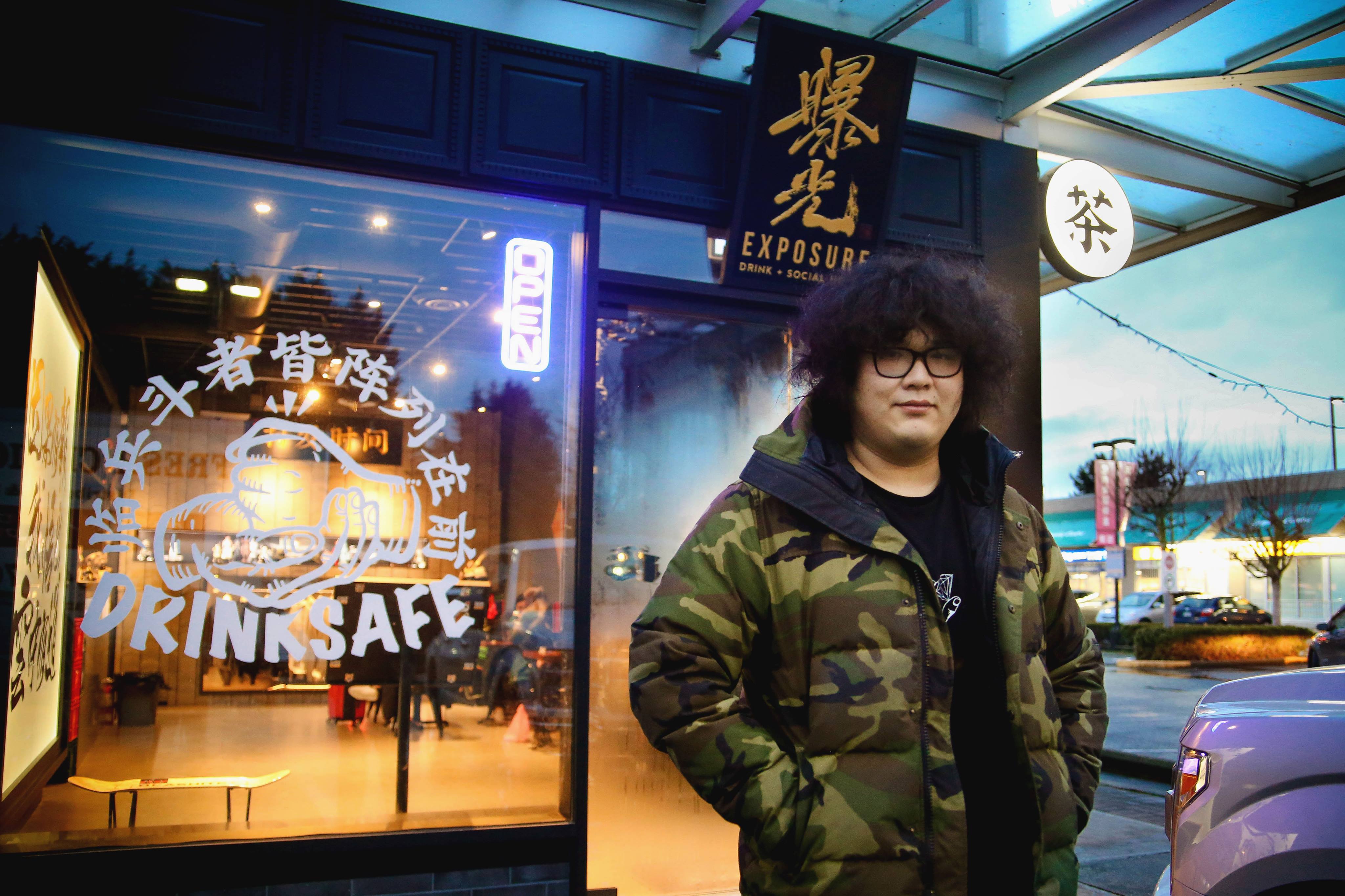A golden bust of Chairman Mao watches from a glowing shelf, flanked by Astro Boy and Godzilla. A skateboard made by billion-dollar streetwear brand Supreme is mounted on the wall like a trophy head. From the ceiling hangs a disco ball.
The slick space also shows off works of Chinese calligraphy, a suit of samurai armour and hoodies emblazoned with the words “fuck rain” — all converging on a granite countertop that seems right out of some new Vancouver condo.
This is Exposure in Richmond, the exuberant evolution of what arrived in B.C. in the 1990s as a simple, Taiwanese hole-in-the wall: the bubble tea shop.
In Metro Vancouver in the past three years, global bubble tea franchises from Taiwan and China have staked out turf from Kerrisdale in Vancouver to Guildford in Surrey.
Exposure, which is not part of a franchise, opened two months ago in a humble suburban strip mall (known for congee and claypot rice) on No. 3 Road near Lansdowne Centre. While its funky glitz might seem easy to dismiss as yet another foodie fad gone upscale, much more is happening here.
Exposure acts as a base, and stage, for hip-hop culture facing a crackdown in China. On some days Exposure hosts car meets, on others, sneaker-design workshops. “Bubble tea is only part of the business,” said main owner Tony Jiang. He is defiantly opposed to the Starbucks-like commodification of bubble tea. Instead, at age 21, he aims to shift the very experience of bubble tea drinking. His holy grail is an elusive vibe behind what the Japanese call omakase.

“Some people have said that we’re just another bubble tea shop but with better design,” said Jiang. “We’re not.”
What Exposure reminds is that immigrant culture not only expands Canada’s, but itself changes at a speedy pace.
Higher tea
At this point I should reveal that I am a faithful lover of bubble tea and have sipped from 99 per cent of the tea-and-tapioca watering holes in these parts since I was nine years old. Exposure, without a doubt, caters to the connoisseur.
Crates of organic milk in glass bottles are stacked by the counter, behind which an expensive machine makes tea one cup at a time with pressurized water, similar to how espresso is brewed.
That bubble tea is now brewed for the high-browed demonstrates how a drink brought to Metro Vancouver by immigrants has persisted in popularity, is growing in complexity, and finding new cultural homes.
“When a new product is introduced, it either fades away or is routinized,” said John Manzo, a University of Calgary sociologist who has researched coffee connoisseurs and enjoys the occasional bubble tea. Sushi, he says, is one example of a food that’s been adopted into North American routines.
Bubble tea, now in every Canadian province, is beginning to break into the North American mainstream. In Toronto, you can find it at Eaton Centre, and in Vancouver, you can find it on Robson Street, popular with the downtown office crowd. In New York, there’s bubble tea in the Flatiron District.
Born of boredom?
Bubble tea loosely refers to all the drinks found at a bubble tea shop, so drinking “bubble tea” could mean drinking a fresh papaya smoothie, a grapefruit soda with yogurt or even a milk tea without the eponymous bubbles.
Bubble tea was invented in 1980s Taiwan, but no one knows exactly how.
A popular story places bubble tea’s origins in Taichung at the Chun Shui Tang Teahouse in 1988. During a boring meeting, Lin Hsiu Hui, the teahouse’s product development manager, is said to have poured her tapioca dessert into her milk tea on a whim.
Whether this creation story is real or not, bubble tea took East and Southeast Asia by storm before popping up in North American communities of the Asian diaspora. Bubble tea arrived in Metro Vancouver with the 1990s spike in Taiwanese migration.
At first, in Metro Vancouver independent entrepreneurs sold the stuff at stalls in migrant malls and Taiwanese diners, many near high schools with large East Asian populations. These were cornerstones of community and transnational connection for young East Asian locals and transplants, abuzz with non-English mother tongues and pop songs from the other side of the Pacific. Local food blogger Diana Wong of Foodology.ca once summed up bubble tea to me as part of the North American experience of “being Asian.” Grabbing one has become a cultural corollary to downing a coffee or beer.
In those years, quality was often hit-or-miss. Some shops I frequented in the early 2000s would use artificial drink crystals for flavouring, turning strawberry bubble tea Pepto-Bismol pink and taro bubble tea into a purple, chalky water. But at shops that got it right, the bubble tea was sugary satisfaction.
It wasn’t until 2015 that the first Taiwanese and Chinese franchises entered Metro Vancouver, late compared to other East Asian overseas communities like Ontario and California. Brands like Chatime and Gong Cha built global empires providing consistent bubble tea. Then came connoisseur bubble tea shops, which took the market to a new level.
Bubble tea and Bourdieu
Yifang, for example, which arrived in Vancouver last year, specializes in fruit teas and is named after the Taiwanese founder’s grandmother, who worked on the family pineapple farm and made pineapple jams. (Pineapple is an integral part of Taiwanese heritage.) The design of the shop is made to look like a traditional tea stall, and the branding emphasizes homey “secret recipes,” “warm hospitality,” “historic memories,” and “authentic and classic Taiwanese flavour.”
Two other Taiwanese franchises, which opened this autumn to lineups out the door, put the craft of pearl production front and centre. Chefs at Xing Fu Tang stir-fry pearls in brown sugar for a roasted flavour. Chefs at OneZo knead a tapioca dough before a machine shapes it into the business’s signature purple pearls. OneZo brags about being the world’s only bubble tea shop that makes pearls in store, calling the process an “art.” Both businesses have glass displays to showcase the theatricality of their artisans, like high-end chocolate or ice cream shops.
These newer, fancier shops charge more than older bubble tea shops, but not by much; their beverages are about five to six dollars as opposed to four or five dollars.
Beyond capitalizing on craft and heritage, these businesses care about selling drinks that look beautiful in your hand and on Instagram. As with lattes or cocktails, bubble tea can be made into art comprising colours, textures and toppings. Juices and teas, milk and cream, fruit and tapioca are layered in clear plastic cups to make a visual statement.
Amy Hanser speaks of “the aesthetic eye” that is “associated with people with a lot of cultural knowledge.” That eye, she says, “can be turned on to anything. You can do it to sushi, you can do it to hamburgers, you can do it to hot dogs.” Hanser is my former sociology professor at the University of British Columbia and studies consumption. “Anything can be aestheticized,” she says, “to meet the taste of the sophisticated cosmopolitan.”
It takes a person with a special sensibility to do that work: a cultural intermediary, a term popularized by French sociologist Pierre Bourdieu, who famously unpacked the topic of taste in his 1979 book Distinction. Tony Jiang of Exposure strikes me as such an intermediary. He disdains anything that’s “pure business” and ignores culture.
For example, Jiang frowns upon western businesses that attempt to woo Chinese buyers thoughtlessly. “A lot of western designers use Chinese characters just to make it look Asian,” he said. One culprit is Danish designer Han Kjobenhavn, whose 2017 collection featured a nonsensical phrase printed in Chinese characters: “Roundhouse kick and bakes white bread.”
Instead, Jiang takes inspiration from the omakase chef-driven Japanese dining experience that’s high-end, slow and intimate.
“From how they decorate the shop to the sushi, it’s about their culture. It’s not just about business, it’s about the craft.”
Some hip hop with your bubble tea?
Exposure is a passion project for Jiang and his friends, some of whom took out loans and sold their cars to help start the business. Jiang was studying psychology at UBC, but dropped out to help run Exposure. The friends chose the name because they want to help “expose” to Canadians Asia’s many teas as well as its street culture and creatives, from fashion to hip hop.
The tea at Exposure is made one cup at a time with that expensive espresso-like machine, not “brewed in a big bucket at the back” like some businesses, says Jiang. The organic milk used is from B.C.’s 107-year-old Avalon Dairy, the same milk Queen Elizabeth drinks when she’s visiting the province.
Exposure serves classic teas like Assam black and rarer ones like Gyukuro, but Jiang is also keen on introducing new teas from other parts of Asia that haven’t received the bubble tea treatment, in line with the foodie desire to taste “exotic” flavours. Jiang has set his eyes on salted milk tea, enjoyed in Mongolia, and saffron, a nod to India and an ingredient he says is “untouched by Chinese.”
Some nights, Exposure becomes a venue for Chinese hip-hop. Jiang and his partners bring in young artists to perform live, many of whom grew up in China listening to America’s giants like Dr. Dre, Eminem, Tupac, and the Notorious B.I.G. When Jiang moved to Canada from China at age 10, he listened to Eminem and Tupac to help with his English. Many of Exposure’s performers — with stage names like Credit and Dr. Lyte — came to Canada from China for university, while pursuing hip-hop as a hobby on the side.
“School comes first,” said Felix Huang, 19, who is pursuing economics at the University of British Columbia and is one of Exposure’s investors. Huang performs as FH. “A label in China asked me to join them, but I would have to move there. I can’t just go, because I’m in university. I feel like it’s part of my responsibility to my parents too.” Huang was introduced to rap through the film 8 Mile, and loves hip hop’s candor. “I can say what I want to say.”
Hip hop blew up in China’s mainstream last year thanks to a competition television show called The Rap of China, but the government is cracking down on the culture for being “vulgar” and having “problematic moral integrity.” Hip hop’s unfiltered language is a problem for the ruling Communists, though Communist rap that trumpets the party is allowed. That’s why there’s a bust of Mao on a shelf at Exposure in place of a Chinese deity.
It’s an “ironic” reminder, said Jiang. “Plus, it’s funny because he’s gold.”

That ironic sensibility, which turns on the tension between the local authentic and the global multicultural, infuses Exposure’s servings and scene. Tea is Asian, but the British added milk to it. In response, the Taiwanese made bubble tea, and Jiang is serving pan-Asian versions of it in Canada. Hip hop came from America, but the genre took on a new life in China, and now Chinese hip hop is being written in Canada, far from a place with state censors and where platforms like YouTube are banned.
Professor Hanser sums up Exposure this way: “It’s cosmopolitan, but it’s also got a very local gloss.”
In the grand scheme of all the things humans have learned to savour, bubble tea is quite young. As Manzo the sociologist warned, new taste sensations can “fade away.” Tony Jiang and his partners at Exposure, as they brew their new mixture of heritage and hip hop, are betting otherwise — the bubble tea bubble isn’t about to pop anytime soon. ![]()
Read more: Food
















Tyee Commenting Guidelines
Comments that violate guidelines risk being deleted, and violations may result in a temporary or permanent user ban. Maintain the spirit of good conversation to stay in the discussion.
*Please note The Tyee is not a forum for spreading misinformation about COVID-19, denying its existence or minimizing its risk to public health.
Do:
Do not: